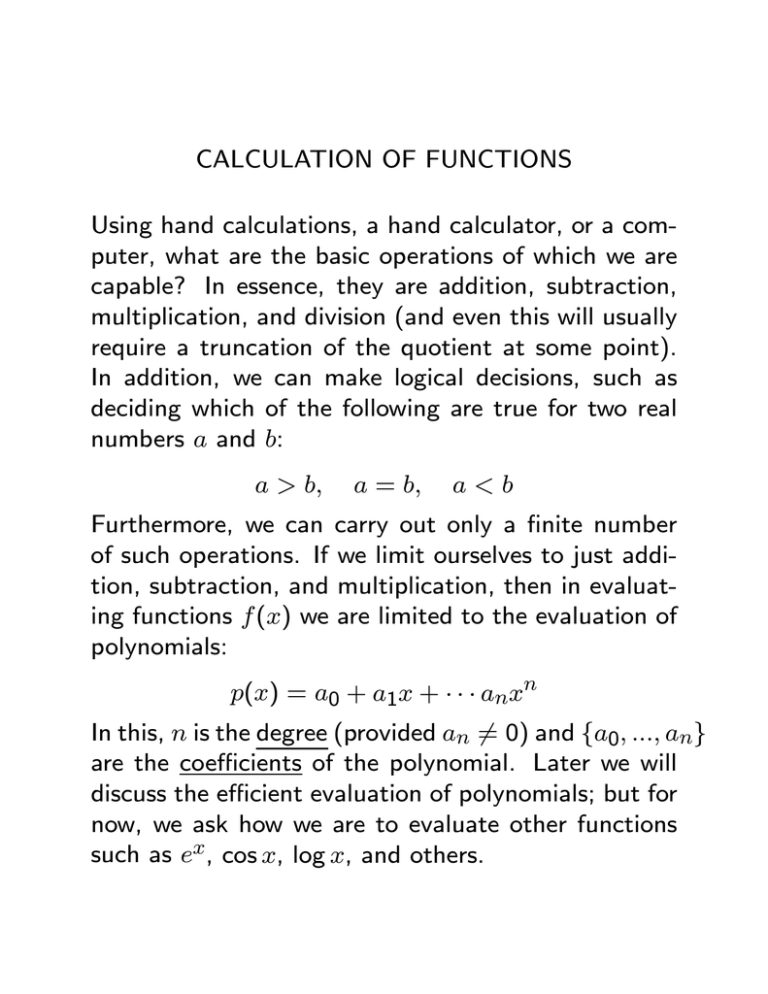CALCULATION OF FUNCTIONS Using hand calculations, a hand
advertisement

CALCULATION OF FUNCTIONS
Using hand calculations, a hand calculator, or a computer, what are the basic operations of which we are
capable? In essence, they are addition, subtraction,
multiplication, and division (and even this will usually
require a truncation of the quotient at some point).
In addition, we can make logical decisions, such as
deciding which of the following are true for two real
numbers a and b:
a > b,
a = b,
a<b
Furthermore, we can carry out only a finite number
of such operations. If we limit ourselves to just addition, subtraction, and multiplication, then in evaluating functions f (x) we are limited to the evaluation of
polynomials:
p(x) = a0 + a1x + · · · anxn
In this, n is the degree (provided an 6= 0) and {a0, ..., an}
are the coefficients of the polynomial. Later we will
discuss the efficient evaluation of polynomials; but for
now, we ask how we are to evaluate other functions
such as ex, cos x, log x, and others.
TAYLOR POLYNOMIAL APPROXIMATIONS
We begin with an example, that of f (x) = ex from
the text. Consider evaluating it for x near to 0. We
look for a polynomial p(x) whose values will be the
same as those of ex to within acceptable accuracy.
Begin with a linear polynomial p(x) = a0 +a1x. Then
to make its graph look like that of ex, we ask that the
graph of y = p(x) be tangent to that of y = ex at
x = 0. Doing so leads to the formula
p(x) = 1 + x
y
y = ex
2
y = p (x)
1
1
-1
1
x
Continue in this manner looking next for a quadratic
polynomial
p(x) = a0 + a1x + a2x2
We again make it tangent; and to determine a2, we
also ask that p(x) and ex have the same “curvature”
at the origin. Combining these requirements, we have
for f (x) = ex that
p(0) = f (0),
p0(0) = f 0(0),
p00(0) = f 00(0)
This yields the approximation
p(x) = 1 + x + 12 x2
y
y = ex
y = p (x)
1
y = p (x)
2
2
1
-1
1
x
We continue this pattern, looking for a polynomial
p(x) = a0 + a1x + a2x2 + · · · + anxn
We now require that
p(0) = f (0),
p0(0) = f 0(0),
· · · , p(n)(0) = f (n)(0)
This leads to the formula
1 xn
p(x) = 1 + x + 12 x2 + · · · + n!
What are the problems when evaluating points x that
are far from 0?
y
.75
x
y = e -p (x)
1
x
y = e -p (x)
2
x
y = e -p (x)
3
x
y = e -p (x)
.50
4
.25
-1
1
x
TAYLOR’S APPROXIMATION FORMULA
Let f (x) be a given function, and assume it has derivatives around some point x = a (with as many derivatives as we find necessary). We seek a polynomial
p(x) of degree at most n, for some non-negative integer n, which will approximate f (x) by satisfying the
following conditions:
p(a) = f (a)
p0(a) = f 0(a)
p00(a) = f 00(a)
..
p(n)(a) = f (n)(a)
The general formula for this polynomial is
1
0
pn(x) = f (a) + (x − a)f (a) + (x − a)2f 00(a)
2!
1
+ · · · + (x − a)nf (n)(a)
n!
Then f (x) ≈ pn(x) for x close to a.
TAYLOR POLYNOMIALS FOR f (x) = log x
In this case, we expand about the point x = 1, making
the polynomial tangent to the graph of f (x) = log x
at the point x = 1. For a general degree n ≥ 1, this
results in the polynomial
1
1
(x − 1)2 + (x − 1)3
2
3
1
+ · · · + (−1)n−1 (x − 1)n
n
Note the graphs of these polynomials for varying n.
pn(x) = (x − 1) −
y
1
1
-1
2
x
y = log x
y = p (x)
1
y = p (x)
2
y = p (x)
3





